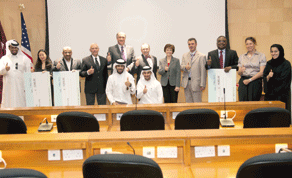 |
| The VDC 2012 teams with officials at the award ceremony yesterday |
The first place was presented to the home team of Dr Nimir Elbashir (assistant professor of chemical engineering), and Jahanur Rahman (chemical and electrical engineering student).
The winning project was titled ‘Development of Visualisation Models for the Correlations between Synthetic Jet Fuels Hydrocarbon Structure and Their Properties.’
The second place, also went to a home team comprising Yasser al-Hamidi (mechanical engineering laboratory manager), and Baher Azzam (mechanical engineering student), for their project, ‘a virtual tour of mechanical engineering laboratories’.
The award for most promising student initiative was given to Dr Mazen Saghir (associate professor of electrical engineering), Dr Shehab Ahmed (assistant professor of electrical engineering), and the group of students who worked on the project, titled ‘Beyond 3D Technology: The Virtual Museum.’
In all, five projects were shortlisted and developed. The others in the final stage were ‘Analysing design with virtual reality’ (Dr L Han, of Virginia Commonwealth University in Qatar), and ‘Human occupation and sea-level change in Wadi Debayan, Northwest Qatar’ (Dr Emma Tetlow, of Qatar Museum Authority and University of Birmingham).
The competition invited researchers across Qatar to submit proposals to develop research projects using the university’s immersive visualisation facility (IVF), which utilises scientific visualisation to create 3D images and graphics that aid in the analysis of complex numerical representation.
This technology helps scientists see data sets in new ways so that they can find patterns or relationships and communicate their data to others. Viewers feel completely immersed in the experience, and all images are displayed in 3D with the use of special goggles.
TAMUQ’s research computing director and VDC chair Dr Othmane Bouhali explained that the selected projects were developed over three months in the IVF with the assistance of in-house visualisation expert.
“As much as 60% of the proposals received this year were from other institutions,” he said while pointing out the increasing popularity of the competition.
The judging committee included Dr Hamid Parsaei (associate dean for academic affairs, TAMUQ), Dr Sebti Foufou (professor of computer science, Qatar University), Muqeem Khan (visiting associate professor of graphics, Northwestern University in Qatar), and Zamri Ahmed (geosciences manager, RasGas).
First place winner Dr Elbashir described the usefulness of immersive visualisation to his project and credited his co-project investigator and student Rahman with conducting excellent work throughout the
competition.
“Our 3D visualisation model will result in speeding up the formulation of new generations of synthetic jet fuels obtained from gas-to-liquid technology that we hope will meet aviation industry standards,” he said.
Rahman was also able to link the experimental and statistical analysis to the visualisation model utilising supercomputers and advanced computer programmes.
Al-Hamidi said that his project involved modelling mechanical engineering laboratories at TAMUQ in order to facilitate tours for campus guests and visitors.
“These virtual tours, when visualised using the IVF, will allow people to witness our state-of-the-art laboratories without physically being inside them.”
The winning teams received a cash award of $4,000 each from Qatar Foundation’s Research Division whereas selected projects got $2,000 each.
Earlier, in his welcome address Dr R Bowen Loftin, president, Texas A&M University, recalled his experiences with visualisation two decades ago, including working with NASA and in the medical field.
Dr Kenneth Hall, associate dean for research and graduate studies, TAMUQ, observed in his opening remarks that visualisation technology is becoming a staple for researchers.
The awards were announced and presented by Dr M Katherine Banks (vice chancellor for engineering, Texas A&M University System and dean of the Dwight Look College of Engineering, Texas A&M University) and TAMUQ dean and CEO Dr Mark H Weichold.

